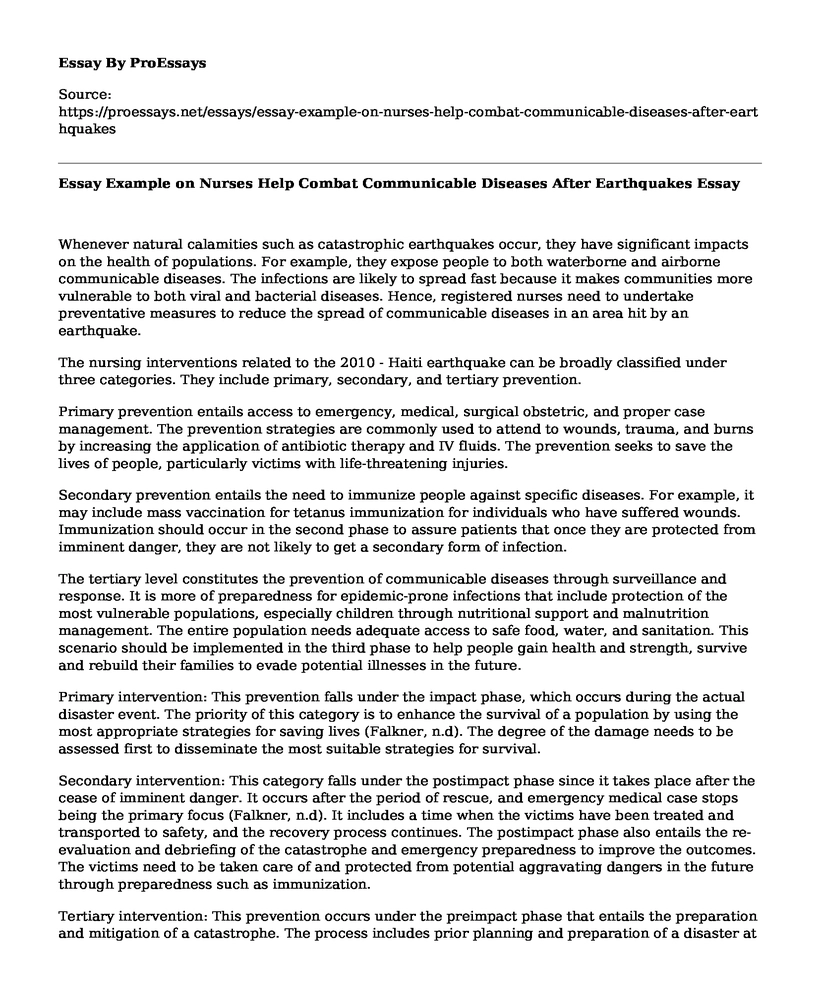Whenever natural calamities such as catastrophic earthquakes occur, they have significant impacts on the health of populations. For example, they expose people to both waterborne and airborne communicable diseases. The infections are likely to spread fast because it makes communities more vulnerable to both viral and bacterial diseases. Hence, registered nurses need to undertake preventative measures to reduce the spread of communicable diseases in an area hit by an earthquake.
The nursing interventions related to the 2010 - Haiti earthquake can be broadly classified under three categories. They include primary, secondary, and tertiary prevention.
Primary prevention entails access to emergency, medical, surgical obstetric, and proper case management. The prevention strategies are commonly used to attend to wounds, trauma, and burns by increasing the application of antibiotic therapy and IV fluids. The prevention seeks to save the lives of people, particularly victims with life-threatening injuries.
Secondary prevention entails the need to immunize people against specific diseases. For example, it may include mass vaccination for tetanus immunization for individuals who have suffered wounds. Immunization should occur in the second phase to assure patients that once they are protected from imminent danger, they are not likely to get a secondary form of infection.
The tertiary level constitutes the prevention of communicable diseases through surveillance and response. It is more of preparedness for epidemic-prone infections that include protection of the most vulnerable populations, especially children through nutritional support and malnutrition management. The entire population needs adequate access to safe food, water, and sanitation. This scenario should be implemented in the third phase to help people gain health and strength, survive and rebuild their families to evade potential illnesses in the future.
Primary intervention: This prevention falls under the impact phase, which occurs during the actual disaster event. The priority of this category is to enhance the survival of a population by using the most appropriate strategies for saving lives (Falkner, n.d). The degree of the damage needs to be assessed first to disseminate the most suitable strategies for survival.
Secondary intervention: This category falls under the postimpact phase since it takes place after the cease of imminent danger. It occurs after the period of rescue, and emergency medical case stops being the primary focus (Falkner, n.d). It includes a time when the victims have been treated and transported to safety, and the recovery process continues. The postimpact phase also entails the re-evaluation and debriefing of the catastrophe and emergency preparedness to improve the outcomes. The victims need to be taken care of and protected from potential aggravating dangers in the future through preparedness such as immunization.
Tertiary intervention: This prevention occurs under the preimpact phase that entails the preparation and mitigation of a catastrophe. The process includes prior planning and preparation of a disaster at the individual and community level (Falkner, n.d). Households may plan on getting the necessary resources includes nutrition, access to food, and water, to assist in responding according to a disaster. The planning may involve healthcare and government agencies to assess the inventory of equipment and resources needed.
The most crucial agency to engage in the case of the Haiti Earthquake would be the local government agencies and healthcare. Often, in times of catastrophes, the local authorities constitute agencies that should offer immediate response to emergencies. They are usually grounded in the area and can easily coordinate amongst themselves to control the impact of a disaster. The local healthcare and government agencies can liaise with the rest of the levels of governments to adequately offer an adequate response to such a scenario.
References
Falkner, A. (n.d). Disaster management: Essential questions.
Cite this page
Essay Example on Nurses Help Combat Communicable Diseases After Earthquakes. (2023, Apr 24). Retrieved from https://proessays.net/essays/essay-example-on-nurses-help-combat-communicable-diseases-after-earthquakes
If you are the original author of this essay and no longer wish to have it published on the ProEssays website, please click below to request its removal:
- Antibiotic Resistance and Impact on Human Health
- Obesity and Diabetes Research Paper Example
- High Nutritional Benefits of Breast Milk Essay
- Paper Example on Health Disparities
- Essay Sample on Health Records of Children: Parental Responsibility & Electronic Confirmation
- Climate Change: Defining Weather & Climate Patterns - Essay Sample
- Case Study Example on US Heart Disease: Cardiac Crisis







